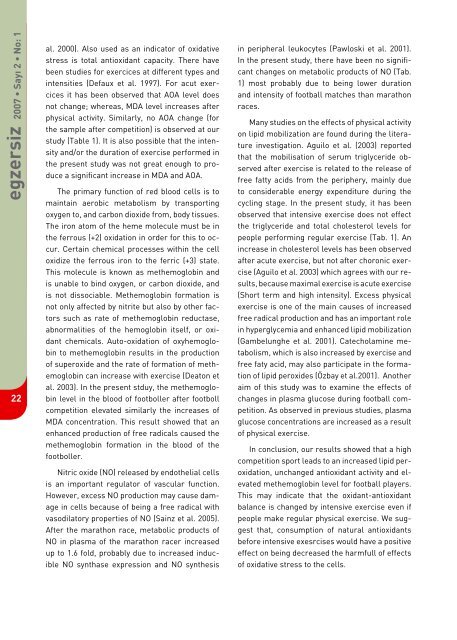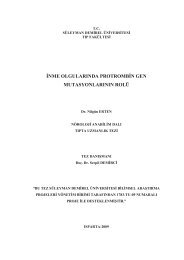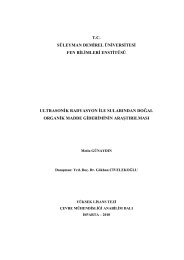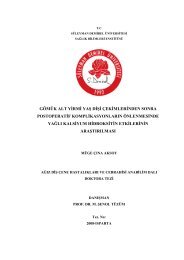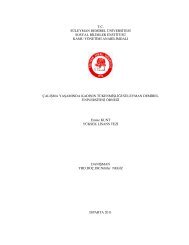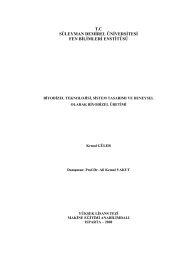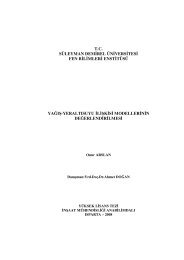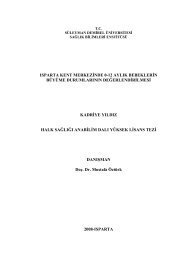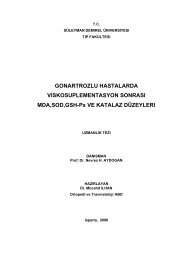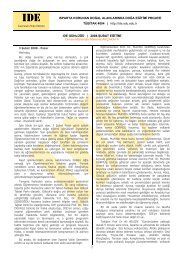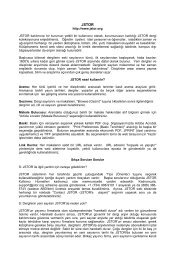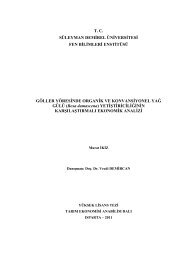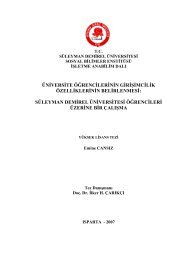Egzersiz Ãevrimiçi Dergi - Süleyman Demirel Ãniversitesi
Egzersiz Ãevrimiçi Dergi - Süleyman Demirel Ãniversitesi
Egzersiz Ãevrimiçi Dergi - Süleyman Demirel Ãniversitesi
Create successful ePaper yourself
Turn your PDF publications into a flip-book with our unique Google optimized e-Paper software.
egzersiz 2007 • Sayı 2 • No: 1<br />
22<br />
al. 2000). Also used as an indicator of oxidative<br />
stress is total antioxidant capacity. There have<br />
been studies for exercices at different types and<br />
intensities (Defaux et al. 1997). For acut exercices<br />
it has been observed that AOA level does<br />
not change; whereas, MDA level increases after<br />
physical activity. Similarly, no AOA change (for<br />
the sample after competition) is observed at our<br />
study (Table 1). It is also possible that the intensity<br />
and/or the duration of exercise performed in<br />
the present study was not great enough to produce<br />
a significant increase in MDA and AOA.<br />
The primary function of red blood cells is to<br />
maintain aerobic metabolism by transporting<br />
oxygen to, and carbon dioxide from, body tissues.<br />
The iron atom of the heme molecule must be in<br />
the ferrous (+2) oxidation in order for this to occur.<br />
Certain chemical processes within the cell<br />
oxidize the ferrous iron to the ferric (+3) state.<br />
This molecule is known as methemoglobin and<br />
is unable to bind oxygen, or carbon dioxide, and<br />
is not dissociable. Methemoglobin formation is<br />
not only affected by nitrite but also by other factors<br />
such as rate of methemoglobin reductase,<br />
abnormalities of the hemoglobin itself, or oxidant<br />
chemicals. Auto-oxidation of oxyhemoglobin<br />
to methemoglobin results in the production<br />
of superoxide and the rate of formation of methemoglobin<br />
can increase with exercise (Deaton et<br />
al. 2003). In the present stduy, the methemoglobin<br />
level in the blood of footboller after footboll<br />
competition elevated similarly the increases of<br />
MDA concentration. This result showed that an<br />
enhanced production of free radicals caused the<br />
methemoglobin formation in the blood of the<br />
footboller.<br />
Nitric oxide (NO) released by endothelial cells<br />
is an important regulator of vascular function.<br />
However, excess NO production may cause damage<br />
in cells because of being a free radical with<br />
vasodilatory properties of NO (Sainz et al. 2005).<br />
After the marathon race, metabolic products of<br />
NO in plasma of the marathon racer increased<br />
up to 1.6 fold, probably due to increased inducible<br />
NO synthase expression and NO synthesis<br />
in peripheral leukocytes (Pawloski et al. 2001).<br />
In the present study, there have been no significant<br />
changes on metabolic products of NO (Tab.<br />
1) most probably due to being lower duration<br />
and intensity of football matches than marathon<br />
races.<br />
Many studies on the effects of physical activity<br />
on lipid mobilization are found during the literature<br />
investigation. Aguilo et al. (2003) reported<br />
that the mobilisation of serum triglyceride observed<br />
after exercise is related to the release of<br />
free fatty acids from the periphery, mainly due<br />
to considerable energy expenditure during the<br />
cycling stage. In the present study, it has been<br />
observed that intensive exercise does not effect<br />
the triglyceride and total cholesterol levels for<br />
people performing regular exercise (Tab. 1). An<br />
increase in cholesterol levels has been observed<br />
after acute exercise, but not after choronic exercise<br />
(Aguilo et al. 2003) which agrees with our results,<br />
because maximal exercise is acute exercise<br />
(Short term and high intensity). Excess physical<br />
exercise is one of the main causes of increased<br />
free radical production and has an important role<br />
in hyperglycemia and enhanced lipid mobilization<br />
(Gambelunghe et al. 2001). Catecholamine metabolism,<br />
which is also increased by exercise and<br />
free faty acid, may also participate in the formation<br />
of lipid peroxides (Özbay et al.2001). Another<br />
aim of this study was to examine the effects of<br />
changes in plasma glucose during football competition.<br />
As observed in previous studies, plasma<br />
glucose concentrations are increased as a result<br />
of physical exercise.<br />
In conclusion, our results showed that a high<br />
competition sport leads to an increased lipid peroxidation,<br />
unchanged antioxidant activity and elevated<br />
methemoglobin level for football players.<br />
This may indicate that the oxidant-antioxidant<br />
balance is changed by intensive exercise even if<br />
people make regular physical exercise. We suggest<br />
that, consumption of natural antioxidants<br />
before intensive exesrcises would have a positive<br />
effect on being decreased the harmfull of effects<br />
of oxidative stress to the cells.


